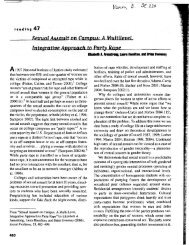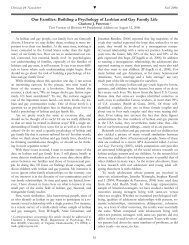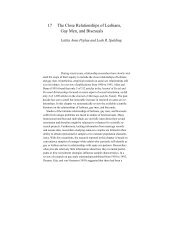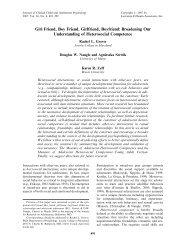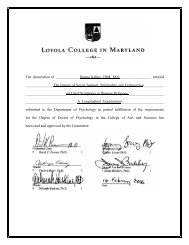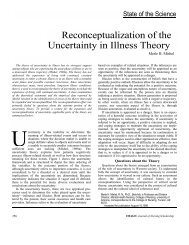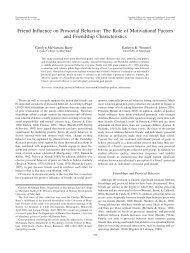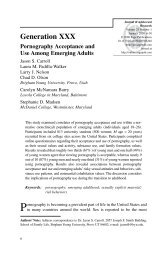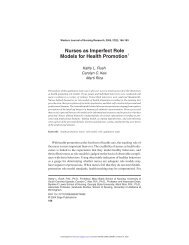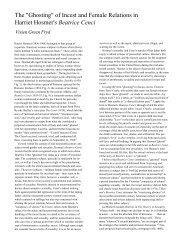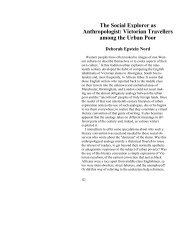I See Satan Fall Like Lightning
I See Satan Fall Like Lightning
I See Satan Fall Like Lightning
You also want an ePaper? Increase the reach of your titles
YUMPU automatically turns print PDFs into web optimized ePapers that Google loves.
I <strong>See</strong> <strong>Satan</strong><br />
<strong>Fall</strong> <strong>Like</strong><br />
<strong>Lightning</strong><br />
Rene Girard<br />
Translated, with a Foreword,<br />
by James G. Williams
F<br />
Chapter 11<br />
The Triumph of the Cross<br />
ROM AN ANTHROPOLOGICAL STANDPOINT I would define Chris-<br />
tian revelation as the true representation 1 of what had never been<br />
completely represented or what had been falsely represented: the<br />
mimetic convergence of all against one, the single victim mecha-<br />
nism with its antecedent developments, particularly "interdividual" 2<br />
scandals.<br />
Mythology falsifies this mechanism to the detriment of victims<br />
and to the advantage of persecutors of the victim. The Hebrew Bible<br />
frequently suggests the truth, evokes it, and even partially represents<br />
it, but never completely and perfectly. The Gospels, taken in their<br />
totality, are this representation, precisely and perfectly.<br />
Once we understand this, a passage from the letter to the<br />
Colossians, which appears obscure at first, becomes illuminating:<br />
[Christ has] canceled the accusation that stands against us with<br />
its legal claims. He set it aside, nailing it to the cross. He thus dis-<br />
armed the principalities and powers and made a public spectacle<br />
of them, drawing them along in his triumph. (Col. 2:14-15)
138 139<br />
The accusation against humankind is the accusation against the<br />
innocent victim that we find in the myths. To hold the principalities<br />
and powers responsible for it is the same thing as holding <strong>Satan</strong><br />
himself responsible, in his role of public prosecutor that I have already<br />
mentioned.<br />
Before Christ and the Bible the satanic accusation was always<br />
victorious by virtue of the violent contagion that imprisoned human<br />
beings within systems of myth and ritual. The Crucifixion reduces<br />
mythology to powerlessness by exposing violent contagion, which<br />
is so effective in the myths that it prevents communities from ever<br />
finding out the truth, namely, the innocence of their victims.<br />
This accusation temporarily relieves communities of their vio-<br />
lence, but it turns back again and "stands against" the persecutors,<br />
for it subjects them to <strong>Satan</strong>, or in other words to the principalities<br />
and powers with their deceitful gods and bloody sacrifices. Jesus,<br />
in showing his innocence in the Passion accounts, has "canceled"<br />
this accusation; he "set it aside." He nails the accusation to the<br />
Cross, which is to say that he reveals its falsity. Though ordinar-<br />
ily the accusation nails the victim to a cross, here by contrast the<br />
accusation itself is nailed and publicly exhibited and exposed as a<br />
lie. The Cross enables the truth to triumph because the Gospels<br />
disclose the falseness of the accusation; they unmask <strong>Satan</strong> as an<br />
imposter. Or to say it in another way, they discredit once and for<br />
all the untruth of the principalities and powers in the wake of the<br />
Cross. The Cross of Christ restores all the victims of the single vic-<br />
tim mechanism, whether it goes under the label of legal accusation,<br />
<strong>Satan</strong>, or principalities and powers.<br />
As <strong>Satan</strong> was making humans obligated to him, putting them in<br />
his debt, he was making them accomplices in his crimes. The Cross,<br />
by revealing the lie at the bottom of <strong>Satan</strong>'s game, exposes human<br />
beings to a temporary increase of violence, but at a deeper level it<br />
liberates them from a servitude that has lasted since the beginning<br />
of human history, since "the foundation of the world."<br />
It is not only the accusation that Christ has nailed to the Cross<br />
and publicly exhibited; the principalities and powers themselves are<br />
paraded, in full public view, in the triumphal process of the crucified<br />
Christ, so in a way they too are crucified. These metaphors are not<br />
at all fantastic and badly improvised; they are so precise it takes<br />
your breath away. Why? Because the revealer and what is revealed<br />
are one: the mimetic war of all against one, concealed in <strong>Satan</strong> and<br />
the powers, is revealed in the crucifixion of Christ as narrated in<br />
the truthful accounts of his Passion.<br />
The Cross and the satanic origin of the false religions and the<br />
powers are one and the same phenomenon, revealed in one case,<br />
concealed in the other. This is why Dante, in his Inferno, represented<br />
<strong>Satan</strong> as nailed to the Cross. 3 When the single victim mechanism is<br />
correctly nailed to the Cross, its ultimately banal, insignificant basis<br />
appears in broad daylight, and everything based on it gradually loses<br />
its prestige, grows more and more feeble, and finally disappears.<br />
The principal metaphor is triumph in the Roman sense, which is<br />
the reward that Rome bestowed on its victorious generals. Standing<br />
on his chariot, the victorious general made a solemn entrance into<br />
the city and received the acclamations of the crowd. The enemy<br />
leaders, in chains, were led along at the rear of the procession. Be-<br />
fore the Romans executed these prisoners, they exhibited them like<br />
ferocious beasts reduced to utter helplessness. Vercingetorix played<br />
this role in the triumph of Caesar. The victorious general here is<br />
Christ, and his victory is the Cross. What Christianity conquers is<br />
the pagan way of organizing the world. The enemy leaders in chains<br />
behind their conqueror are the principalities and powers. The au-<br />
thor compares the irresistible power of the Cross to the power of<br />
military might, the Roman army, which was still utterly dominant<br />
when he wrote.<br />
Of all the Christian ideas, none nowadays arouses more sarcasm<br />
than the one that our text expresses so openly, the idea of a tri-<br />
umph of the Cross. To progressive Christians, proud of their humility,<br />
it seems as arrogant as it is absurd. To characterize the attitude<br />
that they condemn, they have brought the term "triumphalism"
140 141<br />
into fashion. If there exists somewhere a charter of triumphalism, it<br />
must be the text I am discussing here. It may seem to be expressly<br />
written to arouse the indignation of modernists, who are always very<br />
concerned to summon the Church to its obligation of humility.<br />
But this metaphor of triumph contains a paradox so evident that<br />
it has to be deliberate, and it must stem from irony. Military violence<br />
is as alien as possible to the intention of the letter to the Colossians.<br />
The victory of Christ has nothing to do with the military triumph of<br />
a victorious general: rather than inflicting violence on others, Christ<br />
submits to it. What we should retain in the image of triumph is not<br />
the military aspect but the idea of an extraordinary event offered to<br />
the view of all humankind, a public exhibition of what the enemy<br />
had to conceal in order to defend himself. The Cross has stripped<br />
away this defense, this reality that exists through deception.<br />
Christ does not achieve this victory through violence. He obtains<br />
it through a renunciation of violence so complete that violence<br />
can rage to its heart's content without realizing that by so doing,<br />
it reveals what it must conceal, without suspecting that its fury<br />
will turn back against it this time because it will be recorded and<br />
represented with exactness in the Passion narratives.<br />
If we do not detect the role of mimetic contagion in the gene-<br />
sis of social orders, the idea that the principalities and powers are<br />
disarmed and exposed by the Cross will appear absurd, a pure and<br />
simple inversion of the truth. But our text affirms that the Cru-<br />
cifixion produces just the contrary of this standard wisdom. This<br />
wisdom says that the principalities and powers nailed Christ to the<br />
Cross and stripped him of everything without any damage at all to<br />
themselves, without endangering themselves. Our text thus boldly<br />
contradicts everything so-called common sense regards as the hard<br />
and sad truth about the Passion. The powers are not invisible; they<br />
are dazzling presences in our world. They hold the first rank. They<br />
never stop strutting and flaunting their power and riches. There's<br />
no need to make an exhibition of them: they put themselves on<br />
permanent exhibition.<br />
The idea of the triumph of the Cross seems so absurd in the<br />
eyes of the so-called scientific exegetes that they readily see it as<br />
one of those complete inversions that desperate people force on the<br />
real world when their own world founders and they can no longer<br />
face the truth. This is what psychiatrists call "compensation." People<br />
devastated by a completely overwhelming catastrophe, without any<br />
concrete hope, reverse all the signs that inform them about the real<br />
world. They make a "plus" out of every "minus" and a "minus" out<br />
of every "plus," which is exactly what happened to the disciples of<br />
Jesus after the Crucifixion—the believers call it the Resurrection,<br />
but wise skepticism scoffs at such nonsense.<br />
This sociological-psychological approach is the real nonsense.<br />
The precision and sobriety of the accounts of the Crucifixion, also<br />
their unity, more pronounced than the rest of the Gospels, in no way<br />
give the impression of reflecting the kind of psychic catastrophe and<br />
despair, of rupture with reality, that the critics imagine.<br />
It is possible to give a good and rational explanation of the tri-<br />
umph of the Cross without recourse to psychological hypotheses.<br />
The triumph of the Cross reflects and corresponds to a tangible<br />
reality that can be rationally apprehended. The Cross has indeed<br />
transformed the world, and we can interpret its power in a way that<br />
does not have to appeal to religious faith. We can give the triumph<br />
of the Cross a plausible meaning in a completely rational frame or<br />
reference. When they reflect on the Cross, most people see only<br />
the brutality of the event. The terrible death of Jesus takes place,<br />
it seems, in a manner that gives the lie to "triumphalism" in the<br />
most decisive fashion. However, beside the event in all its brutality,<br />
which works to the advantage of the principalities and powers since<br />
it rids them of Jesus, there is another history that goes unrecognized<br />
by most historians and yet is just as objective as the stuff we find in<br />
textbooks. This is the history, not of the events themselves, but of<br />
their representation.<br />
Behind the myths there is an event that governs them, but the<br />
myths do not allow us to identify it, for they distort it and transform<br />
it. But to repeat what I have already insisted on, the Gospels represent<br />
this event as it is, in all its reality, and they make this reality, this
142 143<br />
truth, which human societies had never identified, available to all<br />
humanity.<br />
Outside of the Passion accounts and the songs of the Servant of<br />
Yahweh, the principalities and powers are visible in their external<br />
splendor, but they are invisible and unknown in their interior, in<br />
their shameful, violent origin. The reality behind the scenes is no-<br />
where available except in a few Old Testament texts and the Passion<br />
narratives. For everything pertaining to their false glory, the powers<br />
don't hesitate to take charge of their own publicity. But the Cross<br />
reveals their violent origin, which must remain concealed to pre-<br />
vent their collapse. This is what our text expresses in the image of<br />
the principalities and powers as a "public spectacle" as they bring<br />
up the rear of the procession that Christ leads in victory.<br />
By nailing Christ to the Cross, the powers believed they were<br />
doing what they ordinarily did in unleashing the single victim<br />
mechanism. They thought they were avoiding the danger of dis-<br />
closure. They did not suspect that in the end they would be doing<br />
just the opposite: they would be contributing to their own annihi-<br />
lation, nailing themselves to the Cross, so to speak. They did not<br />
and could not suspect the revelatory power of the Cross.<br />
By depriving the victim mechanism of the darkness that must<br />
conceal it so it can continue to control human culture, the Cross<br />
shakes up the world. Its light deprives <strong>Satan</strong> of his principal power,<br />
the power to expel <strong>Satan</strong>. Once the Cross completely illuminates<br />
this dark sun, <strong>Satan</strong> is no longer able to limit his capacity for<br />
destruction. <strong>Satan</strong> will destroy his kingdom, and he will destroy<br />
himself.<br />
To understand this is to understand why Paul sees the Cross as the<br />
source of all knowledge about the world and human beings as well<br />
as about God. When Paul asserts that he wants to know nothing<br />
besides Christ crucified, he is not engaging in "anti-intellectualism."<br />
He is not announcing his contempt for knowledge. Paul believes<br />
quite literally that there is no knowledge superior to knowing the<br />
crucified Christ. If we go to this school, we will learn more about<br />
God and humankind simultaneously than if we look to any other<br />
source of knowledge. His suffering on the Cross is the price Jesus is<br />
willing to pay in order to offer humanity this true representation of<br />
human origins that holds it prisoner. In offering himself in this way,<br />
he deprives the victim mechanism of its power in the long run.<br />
In the triumph of a victorious general the humiliating display<br />
of those who are conquered is only a consequence of the victory<br />
achieved, whereas in the case of the Cross this display is the vic-<br />
tory itself; it is the unveiling of the violent origin of culture. The<br />
powers are not put on display because they are defeated, but they<br />
are defeated because they are put on display.<br />
There is an irony, therefore, in the metaphor of military triumph,<br />
and what gives it its edge is the fact that <strong>Satan</strong> and his cohorts<br />
respect nothing but power. They think only in terms of military<br />
triumph. They are beaten by a weapon whose effectiveness they<br />
could not conceive, that contradicts all their beliefs, all their values.<br />
It is the most radical weakness that defeats the power of satanic<br />
self-expulsion.<br />
To UNDERSTAND the difference between mythology and the Gospels,<br />
between mythic concealment and Christian revelation, we must<br />
avoid confusing the representation with what is represented.<br />
Many readers imagine that when something is represented in a<br />
text, then the text is under the sway of its own representation.<br />
They think that the single victim mechanism must dominate the<br />
Gospels because only in them, and nowhere else, is it really visible.<br />
By the same token, they take this same mechanism as absent from<br />
mythology because the myths never represent it, because they give<br />
no explicit indication of its presence.<br />
These exegetes are astonished then to hear me say that collec-<br />
tive murder is essential to the generation of myths, and that it has<br />
nothing to do with the origin of the Gospels. The Gospels present it<br />
again or re-present it, but their origin lies in the life and deeds and<br />
teachings of Christ, whose love and suffering reveal our violence for<br />
what it is. Collective murder, or the single victim mechanism, has<br />
everything to do with the origin of the texts that do not represent
144 145<br />
it and cannot represent it precisely because they are based on it,<br />
because the victim mechanism is their generating principle. These<br />
texts are the myths.<br />
The exegetes are dupes of the modern bias of concluding too<br />
quickly that texts dealing with collective violence are violent texts<br />
whose violence we have the duty to denounce. Under the influ-<br />
ence of the Nietzsche tradition (see chapter 14), our bias tends to<br />
function on the principle of "no smoke without fire." This is as mys-<br />
tifying as can be in the subject concerning us here. The exegetes<br />
treat the Judeo-Christian revelation as a kind of Freudian or Niet-<br />
zschean symptom in the sense of the "slave morality." They see the<br />
revelation of the victim mechanism as the leveling effect of social<br />
resentment, for example. They never wonder whether by chance<br />
this revelation may be justified.<br />
Only wherever it is not represented can mimetic snowballing play<br />
a generative role due to the very fact that it is not represented, that<br />
it misunderstands itself. As soon as mimetic contagion has taken<br />
over the community, its members are possessed by it. Violent con-<br />
tagion speaks for them; mimetic violence pronounces the guilt of<br />
the victim and the innocence of the persecutors. The community<br />
no longer speaks; the speaker is rather the one the Gospels name as<br />
the accuser, <strong>Satan</strong>.<br />
Pseudoscientific exegetes don't see that the biblical basis of Ju-<br />
daism and Christianity transmits the first revelatory and liberating<br />
representations regarding violence. Violence has always existed, but<br />
until the biblical revelation it remained concealed in the infra-<br />
structure of mythology. Under the influence of Nietzsche and Freud,<br />
our contemporaries go and find in these texts, whose referentiality<br />
is denied without the least proof, various indications of a "persecu-<br />
tion complex" with which Judaism and Christianity as a whole are<br />
alleged to be afflicted. Mythology, on the other hand, is held to be<br />
exempt from this complex.<br />
The proof that all this is absurd is the superb indifference, the<br />
regal contempt, that mythology shows toward any suggestion of<br />
possible violence of the strong against the weak, of those in the<br />
majority against the minority, of the healthy against the ill, of the<br />
normal against the abnormal, of the native against the foreigners,<br />
and so on.<br />
Modern confidence in the myths is even stranger in our day when<br />
our contemporaries are terribly suspicious regarding their own soci-<br />
ety. They see hidden victims everywhere except where they really<br />
are, in the myths that they never look at with a critical eye.<br />
Contemporary thinkers, still under Nietzschean influence, have<br />
the habit of seeing the myths as kindly texts, sympathetic, cheer-<br />
ful, and lively. Mythology is regarded as superior in every way to<br />
the Jewish and Christian Scriptures, which are dominated, not by<br />
a legitimate concern for justice and truth, but by morbid suspi-<br />
cion. Most intellectuals in the present world seem to adopt this<br />
perspective. What sells this view is the apparent absence of un-<br />
just violence in the myths or the aesthetic transformation of violent<br />
deeds. By contrast, the Jewish and Christian Scriptures come across<br />
as so obsessed with persecutions that their relationship to them must<br />
at least suggest their own guilt. To grasp this misunderstanding in<br />
its enormity, we must see it in light of a case of unjust condem-<br />
nation of a victim. My example is the famous Dreyfus case, an<br />
affair so thoroughly clarified that it now eliminates any possibility of<br />
misunderstanding.<br />
In the late nineteenth and early twentieth centuries, when Cap-<br />
tain Dreyfus, condemned for a crime he had not committed, was<br />
serving his sentence, there were, on one side, the "anti-Dreyfus"<br />
people, who were numerous and perfectly serene and satisfied, for<br />
they had their collective victim, and they congratulated themselves<br />
on seeing him justly punished. On the other side were the defenders<br />
of Dreyfus, very, very few at first. For a long time people viewed them<br />
as obvious traitors or professional malcontents, always occupied with<br />
chewing over all sorts of grievances and suspicions whose real basis<br />
no one around them could see. Critics looked for the motives of<br />
their behavior in personal morbidity or political prejudices.<br />
In fact, anti-Dreyfusism was a true myth, a false accusation that<br />
the accusers confused with truth. Mimetic contagion maintained a
146 147<br />
contagion so kindled by anti-Semitic prejudice that no disclosure of<br />
the real facts of the case during these years succeeded in shaking it.<br />
Those who celebrate the "innocence" of the myths, their joy in<br />
life, and their healthy outlook and who put all that in opposition to<br />
the sickly suspicion of the Hebrew Bible and the Gospels commit<br />
a grave error. It is the same error, in my view, as those who opted<br />
for anti-Dreyfusism against Dreyfusism. One writer and poet of that<br />
period, Charles Peguy (1873-1914), perceived the analogy with the<br />
Passion of Christ.<br />
If the supporters of Dreyfus had not fought for their point of view,<br />
if they had not suffered (at least some of them) for the truth, if they<br />
had admitted, as have some in our day, that to believe there is such<br />
a thing as truth is the fundamental sin—then Dreyfus would never<br />
have been vindicated, and the lie would have won the victory.<br />
If we admire the myths that don't detect the innocent victims<br />
in their own stories and condemn the Bible because it does, then<br />
we relapse into the illusion of the anti-Dreyfus majority, which re-<br />
fused to consider the possibility of a judicial error. Through much<br />
struggle and suffering the supporters of Dreyfus achieved a triumph<br />
for a truth as absolute, intransigent, and dogmatic as Joseph's in his<br />
opposition to mythological violence.<br />
THE VICTIM MECHANISM is not a literary theme like many others;<br />
it is a principle of illusion. As such, it cannot appear at all in the<br />
texts it controls. If this mechanism appears explicitly as a principle<br />
of illusion, as it does in the Old Testament and New Testament, it<br />
does not dominate them in the sense that it dominates texts where<br />
it remains invisible, unsuspected, as in the myths.<br />
No text can illuminate the process of mimetic snowballing on<br />
which it is based; no text can have its basis in the violent contagion<br />
it illuminates. Thus we must guard against confusing the question<br />
of the victim of the unanimous crowd with what the literary critic<br />
talks about, namely, a theme or motif that we ascribe to a writer<br />
when it shows up in his or her writings, and that we don't ascribe,<br />
of course, if it does not show up.<br />
It is easy to recognize this error, but it is even easier not to recog-<br />
nize it, and as a rule, it goes unrecognized. Hardly anyone suspects<br />
that if the myths never speak of arbitrary violence, this could be be-<br />
cause they unknowingly reflect the virulence of a persecution that<br />
does not recognize its victims anywhere but sees them as justly ex-<br />
pelled culprits—victims like Oedipus, for example, who are supposed<br />
to have "really" committed parricide and incest.<br />
It is mimetic contagion that completely determines the contents<br />
of mythology. The myths are so much in its thrall that they can-<br />
not suspect their own subjection. No text can make allusion to the<br />
principle of illusion that governs it.<br />
To be a victim of illusion is to take it for true, so it means one is<br />
unable to express it as such, as illusion. By being the first to point out<br />
persecutory illusion, the Bible initiates a revolution that, through<br />
Christianity, spreads little by little to all humanity without being<br />
really understood by those whose profession and pride are to under-<br />
stand everything. This is one of the reasons, I believe, Jesus speaks<br />
the literal truth when he exclaims: "I thank you, Father... that you<br />
have hidden these things from the wise and clever and revealed<br />
them to babes" (Matt. 11:25).<br />
The necessary condition enabling the single victim mechanism<br />
to dominate a text is that it does not appear as an explicit theme.<br />
And vice versa: a victim mechanism cannot dominate a text—the<br />
Gospels—in which it explicitly appears. This involves a paradox<br />
that forces us to see our dreadful blindness to the greatness of the<br />
Passion accounts. It is always the individual or the revelatory text<br />
that is taken to be responsible for the inexcusable violence it re-<br />
veals. We tend, in short, to hold the messenger responsible for the<br />
unpleasantness of the message, as Cleopatra does in Shakespeare s<br />
play. The specific character of myths is to hide their own violence. It<br />
is the character of the Jewish and Christian Scriptures to reveal the<br />
same violence and to suffer the consequences in the eyes of blind<br />
humanity.<br />
The principle of illusion or victim mechanism cannot appear in<br />
broad daylight without losing its structuring power. In order to be
148<br />
effective, it demands the ignorance of persecutors who "do not know<br />
what they are doing." It demands the darkness of <strong>Satan</strong> to function<br />
adequately.<br />
The myths are not aware of their own violence, which they<br />
project upon the higher transcendent level by demonizing and then<br />
deifying their victims. It is just this transfigured violence that be-<br />
comes visible in the Bible. The victims are seen as true victims, no<br />
longer guilty but innocent. The persecutors are seen as true persecu-<br />
tors, no longer innocent but guilty. It is not merely our predecessors<br />
whom we unceasingly accuse who are guilty; we all stand in need<br />
of pardon.<br />
A myth is a lie in the sense that it is the deceptive nonrepresenta-<br />
tion that mimetic contagion and its victim mechanism generate by<br />
means of the community that becomes their instrument. The mi-<br />
metic contagion is never objectified; it is never represented in the<br />
mythic narrative. It is its real subject, therefore, but it is always<br />
concealed as such. It is what the Gospels call <strong>Satan</strong>, or the devil.<br />
THE PROOF that it is difficult, or perhaps too easy, to understand<br />
what I have just said is that <strong>Satan</strong> himself did not understand it.<br />
Or rather, he understood it, but too late to protect his realm. His<br />
slowness has had tremendous consequences for human history.<br />
Paul writes to the Corinthians: "If the princes of this world had<br />
known [the wisdom of God] they would not have crucified the<br />
Lord of glory" (1 Cor. 2:8). "The princes of this world" are here the<br />
same thing as <strong>Satan</strong>; they crucified the Lord of glory because they<br />
expected the results of this event to be favorable to their interests.<br />
They were hoping that the victim mechanism would function as<br />
usual, protected from any suspicions, and that they would thus rid<br />
themselves of Jesus and his message. At the beginning of the matter<br />
they had very good reason to think that everything would happen<br />
cleanly and quickly.<br />
The crucifixion of Jesus is a victim mechanism like the others;<br />
it is set in motion and develops like the others. Yet its outcome is<br />
different from all the others.<br />
Until the Resurrection no one could foresee the reversal of the<br />
violent contagion that almost completely overcame the disciples<br />
themselves. The princes of this world could rub their hands in sat-<br />
isfaction, and yet it turned out that their calculations were undone.<br />
Instead of conjuring away once more the secret or the single vic-<br />
tim mechanism, the four accounts of the Passion broadcast it to the<br />
four corners of the world, publicizing it whetever they were read<br />
and proclaimed.<br />
Starting from Paul's statement that I have just quoted, Origen and<br />
many of the Greek Fathers elaborated a thesis that played a great<br />
role as the first centuries of Christianity unfolded, that of <strong>Satan</strong> duped<br />
by the Cross. 4 <strong>Satan</strong> means the same in this formulation as those<br />
St Paul names as the "princes of this world." In Western Christianity<br />
this thesis has not met with the same favor as in the East, and finally,<br />
as far as 1 know, it disappeared. Western theologians suspected it of<br />
being "magical thought." They have wondered whether it attributes<br />
a role to God that is unworthy.<br />
The thesis interprets the Cross as a kind of divine trap, a ruse of<br />
God that is even stronger and cleverer than <strong>Satan</strong>'s ruses. Certain<br />
Fathers amplified this idea into a strange metaphor that contributed<br />
to the distrust in the West. Christ is compared to the bait the fisher<br />
puts on the hook to catch a hungry fish, and that fish is <strong>Satan</strong>.<br />
The role this discourse ascribes to <strong>Satan</strong> troubles the Western<br />
thinkers. As times passes, the devil's place shrinks in Western theo-<br />
logical thought. His disappearance is troublesome to the extent that<br />
<strong>Satan</strong> is the same thing as mimetic contagion, which alone can clar-<br />
ify the true meaning and validity of the patristic metaphor of <strong>Satan</strong><br />
duped by the Cross. The discovery of the mimetic, or satanic, cycle<br />
enables us to understand that this metaphor contains an essential<br />
insight. It takes into account the fact that mimetic conflicts and<br />
mimetic pride are the main obstacle to the Christian revelation.<br />
Mythical-ritual societies are prisoners of a mimetic circle that they<br />
cannot escape since they are unable to identify it. This continues<br />
149
150 151<br />
to be true today: all our ideas about humankind, all our philoso-<br />
phies, all our social sciences, all our psychological theories, etc.<br />
are fundamentally pagan because they are based on a blindness to<br />
the circularity of mimetic conflict and contagion. This blindness is<br />
similar to that of mythical-ritual systems.<br />
The Passion accounts, allowing us to understand the single vic-<br />
tim mechanism and its mimetic cycles, enable us to find and identify<br />
our invisible prison and to comprehend our need for redemption.<br />
Since the "princes of this world" were not in communion with<br />
God, they did not understand that the victim mechanism they un-<br />
leashed against Jesus would result in truthful accounts. If they had<br />
been able to read the future, not only would they not have en-<br />
couraged the Crucifixion, but they would have opposed it with all<br />
their might.<br />
When the princes of this world finally understood the real import<br />
of the Cross, it was too late to turn back: Jesus had been crucified,<br />
and the Gospels had been written. Thus Paul is right to affirm: "If<br />
the princes of this world had known [the wisdom of God] they would<br />
not have crucified the Lord of glory." Western theology, in rejecting<br />
the idea of <strong>Satan</strong> tricked by the Cross, has lost a pearl of great price<br />
in the sphere of anthropology.<br />
Medieval and modern theories of redemption all look in the di-<br />
rection of God for the causes of the Crucifixion: God's honor, God's<br />
justice, even God's anger, must be satisfied. These theories don't<br />
succeed because they don't seriously look in the direction where the<br />
answer must lie: sinful humanity, human relations, mimetic conta-<br />
gion, which is the same thing as <strong>Satan</strong>. They speak much of original<br />
sin, but they fail to make the idea concrete. That is why they give<br />
an impression of being arbitrary and unjust to human beings, even<br />
if they are theologically sound.<br />
Once we identify the bad contagion, the idea of <strong>Satan</strong> duped<br />
by the Cross acquires a precise meaning that the Greeks obviously<br />
sensed without succeeding in articulating it in a completely satisfy-<br />
ing fashion. To be a "child of the devil" in the sense of the Gospel of<br />
John, as we have seen, is to be locked into a deceptive system of mi-<br />
metic contagion that can only lead into systems of myth and ritual.<br />
Or, in our time, it leads into those more recent forms of idolatry,<br />
such as ideology or the cult of science.<br />
The Greek Fathers had it right in saying that with the Cross<br />
<strong>Satan</strong> is the mystifier caught in the trap of his own mystification.<br />
The single victim mechanism was his personal property, his very<br />
own thing, the instrument of self-expulsion that put the world at<br />
his feet. But in the Cross this mechanism escapes once and for all<br />
from the control <strong>Satan</strong> exercised over it, and as a result the world<br />
looks completely different.<br />
If God allowed <strong>Satan</strong> to reign for a certain period over human-<br />
kind, it is because God knew beforehand that at the right time<br />
Christ would overcome his adversary by dying on the Cross. God<br />
in his wisdom had foreseen since the beginning that the victim<br />
mechanism would be reversed like a glove, exposed, placed in the<br />
open, stripped naked, and dismantled in the Gospel Passion texts,<br />
and he knew that neither <strong>Satan</strong> nor the powers could prevent this<br />
revelation.<br />
In triggering the victim mechanism against Jesus, <strong>Satan</strong> believed<br />
he was protecting his kingdom, defending his possession, not realiz-<br />
ing that, in fact, he was doing the very opposite. He did exactly what<br />
God had foreseen. Only <strong>Satan</strong> could have set in motion the process<br />
of his own destruction without suspecting anything was wrong.<br />
All we need to make the thesis of <strong>Satan</strong> duped by the Cross<br />
intelligible is a clear definition of what imprisons human beings in<br />
the realm of <strong>Satan</strong>: mimetic contagion and its outcome in the victim<br />
mechanism have provided us with that definition. We should not<br />
conclude that to identify the truth is enough to liberate us from the<br />
lies in which we are all imprisoned.<br />
The apostle Paul's text, from which I took the sentence that I<br />
just commented on, is the expression of extraordinary inspiration.<br />
Paul there intuits the existence of a divine plan that bears on all of<br />
human history, but he cannot quite formulate it. He goes into what<br />
may almost be called "ecstatic stammering" for lack of a language<br />
that could perform the task. He evokes
152<br />
a secret and hidden wisdom of God, which God decreed before<br />
the ages for our glory. None of the rulers of this age understood<br />
this, for if they had known they would not have crucified the<br />
Lord of glory. But as it is written, "What eye has not seen, nor<br />
ear heard, nor the heart of man conceived, God has prepared<br />
for those who love him." (1 Cor. 2:7-9)<br />
God permitted <strong>Satan</strong> to reign for a time over humanity, foresee-<br />
ing that at the appointed time God would overcome him on the<br />
Cross. The divine wisdom knew that thanks to this death the vic-<br />
tim mechanism would be neutralized. <strong>Satan</strong> would be completely<br />
unable to elude this trap; he would participate in God's plan un-<br />
awares. The Greek Fathers, in treating <strong>Satan</strong> as the victim of a kind<br />
of divine ruse, suggest aspects of revelation now obscured because<br />
the anthropology of the Cross remains obscure.<br />
<strong>Satan</strong> himself has thus placed the truth at the disposal of human-<br />
kind; he has made it possible to overturn his own lie; he has rendered<br />
the truth of God universally understandable.<br />
The idea of <strong>Satan</strong> duped by the Cross is therefore not magical at<br />
all and in no way offends the dignity of God. The trick that traps<br />
<strong>Satan</strong> does not include the least bit of either violence or dishonesty<br />
on God's part. It is not really a ruse or trick; it is rather the inability<br />
of the prince of this world to understand the divine love. If <strong>Satan</strong><br />
does not see God, it is because he is violent contagion itself. The<br />
devil is extremely clever concerning everything having to do with<br />
rivalistic conflicts, with scandals and their outcome in persecution,<br />
but he is blind to all reality other than that. <strong>Satan</strong> turns bad con-<br />
tagion into something I hope not to do myself, a totalitarian and<br />
infallible theory that makes the theoretician deaf and blind to the<br />
love of God for humankind and to the love that human beings share<br />
with God, however imperfectly.<br />
<strong>Satan</strong> himself transforms his own mechanism into a trap, and he<br />
falls into it headlong. God does not act treacherously, even toward<br />
<strong>Satan</strong>, but allows himself to be crucified for the salvation of human-<br />
kind, something beyond <strong>Satan</strong>'s conception. The prince of this world<br />
depended too heavily on the extraordinary power of concealment<br />
of the victim mechanism.<br />
The Gospels themselves draw our attention to the loss of mythic<br />
unanimity everywhere Jesus comes and intervenes. John in partic-<br />
ular points out on numerous occasions how the witnesses become<br />
divided after Jesus speaks and acts. Each time, the people around<br />
Jesus quarrel, and far from unifying them, his message precipitates<br />
disharmony and division. In the Crucifixion especially, this divi-<br />
sion plays a primary role. Without it there would not be a Gospel<br />
revelation; the single victim mechanism would not be truthfully rep-<br />
resented. It would be, as in the myths, transformed and concealed<br />
as just and legitimate action.<br />
153



